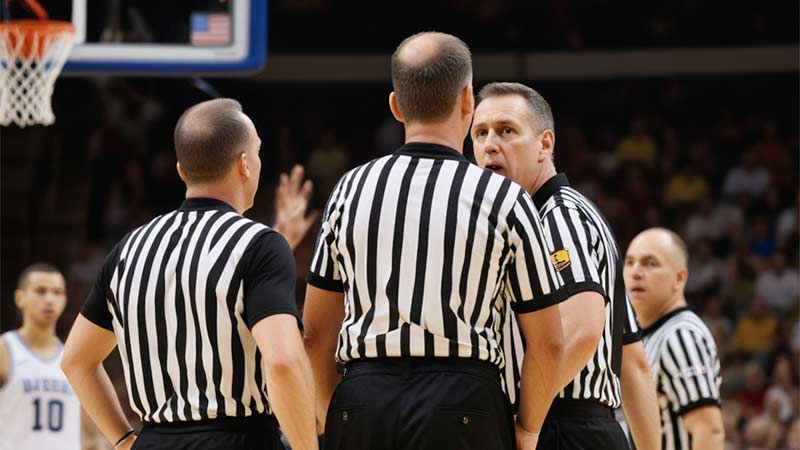In basketball, penalties play a crucial role in maintaining the flow and fairness of the game. When a team accumulates a specific number of fouls, they enter the penalty situation, commonly referred to as the bonus.
This means that each subsequent foul results in the opposing team taking free throws, regardless of the type of foul committed.
Understanding the penalty rules is essential for both players and fans. Different leagues, such as the NBA, NCAA, and FIBA, have varying thresholds for when a team enters the penalty.
For instance, in the NBA, teams are allowed a set number of fouls per quarter before giving up free throws, whereas in NCAA play, the fouls reset every half.
This strategic element adds another layer of complexity to the game, as teams with fouls to give can disrupt their opponents without immediate repercussions.
Types of Penalties in Basketball
In basketball, penalties are sanctions imposed on players for various infractions committed during the game. Here are some common types of penalties in basketball:
Personal Fouls
Personal fouls are the most common form of violations in basketball, arising from illegal physical contact between players. These fouls can occur on both the offensive and defensive sides.
Actions leading to personal fouls include pushing, holding, tripping, or charging into an opponent. The consequences depend on whether the fouled player was in the act of shooting. Non-shooting fouls result in the team losing possession.
If the player was shooting and missed, they are awarded free throws—two for a two-point attempt and three for a three-point attempt. If the shot was successful, one additional free throw is awarded.
Technical Fouls
Technical fouls differ in that they usually involve unsportsmanlike behavior or violations by players or coaches. These do not necessarily involve physical contact. Examples include arguing with referees, inappropriate sideline conduct from coaches, or players taunting opponents.
Other causes include delaying the game by touching the ball post-score or excessively hanging on the rim after a dunk. A single technical foul leads to one free throw for the opposing team.
Additionally, severe actions such as throwing objects at an official or into the stands can result in immediate ejection from the game.
Flagrant Fouls
Flagrant fouls are severe and involve excessive or violent contact that could potentially injure an opponent. These fouls are classified into two levels: Flagrant 1 and Flagrant 2. A Flagrant 1 foul results in free throws and the offending player staying in the game with a warning.
A Flagrant 2 foul is more serious, leading to the ejection of the player from the game in addition to the free throws awarded to the opposing team. The rules ensure player safety and maintain the competitive integrity of the sport by penalizing excessive and dangerous actions.
Penalty Enforcement and Procedures
In basketball, penalty enforcement and procedures vary depending on the type of penalty incurred. Here’s a general overview:
Free Throws and Possession Changes
Free throws are awarded as a result of specific fouls. Successful free throws earn one point each. The type of foul determines the number of free throws.
- Shooting Foul: If a player is fouled while attempting a shot, they receive two or three free throws, depending on whether the shot was a two-pointer or a three-pointer.
- Non-Shooting Foul: For non-shooting fouls, free throws are awarded if the fouling team is over the limit (the bonus situation). Otherwise, the team gains possession without free throws.
- Flagrant Foul: A flagrant foul results in two free throws and possession of the ball for the fouled team. A flagrant 2 foul also leads to player ejection and a fine.
Possession changes occur under various circumstances:
- Offensive Fouls: An offensive foul results in a change of possession, with no points awarded to the fouling team.
- Technical Fouls: Technical fouls often result in one or more free throws for the opposing team, and they retain possession.
- Loose Ball Fouls: A loose ball foul can lead to either free throws if in a bonus situation or a change of possession to the non-fouling team.
Effects of Accumulated Fouls
Accumulated fouls impact the game by affecting team and player strategies.
- Team Fouls: When a team exceeds a preset number of fouls in a quarter, they’re considered in the penalty. This results in the opposing team being awarded free throws for each subsequent foul.
- Individual Player Fouls: Players “foul out” after committing six personal fouls in the NBA, combining both personal and technical fouls. Once fouled out, the player can no longer participate in the game.
- Game Flow and Momentum: Frequent fouls can disrupt the game’s pace, leading to more free throws and extended stoppages. This can shift momentum by allowing the opposing team to score with minimal effort.
Understanding and adhering to penalty procedures help maintain the balance and fairness of the game.
Comparison Across Leagues
When comparing how penalties are enforced and the procedures followed across different basketball leagues, such as the NBA, FIBA, and NCAA, several key differences and similarities can be observed:
NBA and WNBA Penalties
In the NBA and WNBA, teams enter the penalty situation if they commit five fouls in a quarter or two fouls in the final two minutes, resulting in the opposing team getting two free throws on the next foul.
In overtime, the period starts with the rule of two free throws after the fourth team foul or the second foul in the final two minutes.
Players are disqualified after six personal fouls in a game, and technical and flagrant fouls come with additional penalties like free throws and potential ejection, maintaining discipline and ensuring fair play.
NCAA Basketball Penalties
NCAA basketball rules include specific handling of team and individual penalties. Teams enter the bonus after the seventh team foul in a half, granting the opposing team a one-and-one free throw situation. After the tenth team foul, the penalty escalates to two free throws.
Individual players are disqualified after five personal fouls, unlike in the NBA where the limit is six.
Technical fouls also carry significant consequences with awarded free throws and possession changes, ensuring the collegiate game remains structured and upholds sportsmanship.
International Rules – FIBA
FIBA rules, followed in most international competitions, also set specific guidelines for penalties. Teams enter the penalty phase after committing five team fouls in a quarter.
Each subsequent foul awards the opposing team two free throws, similar to the NBA but with some variations in enforcement.
Individual players face disqualification after five personal fouls. FIBA places additional importance on technical fouls, which lead to immediate free throws and possession changes, maintaining game integrity and player conduct on a global stage.
These rules ensure consistency across numerous international tournaments and leagues.
Common Misconceptions About Basketball Penalties
There are a few common misconceptions about basketball penalties that are worth clarifying:
The Difference Between Personal and Technical Fouls
People often confuse personal and technical fouls. Personal fouls involve illegal physical contact with an opponent. Examples include holding, pushing, or hitting another player. In contrast, technical fouls are related to unsportsmanlike conduct or noncontact rule violations.
These may include arguing with referees or using inappropriate language. Clear understanding of these distinctions helps players avoid unnecessary penalties and maintain fair play.
Misinterpretation of Flagrant Fouls
Flagrant fouls are frequently misunderstood. These fouls involve violent or excessively aggressive actions, posing a risk of injury to an opponent. They lead to ejections from the game and additional disciplinary actions.
Unlike regular personal fouls, flagrant fouls focus on the severity and intent behind the action. Recognizing what constitutes a flagrant foul ensures players understand the serious nature of these actions and the significant consequences they carry.
Strategies to Minimize Penalties
Minimizing penalties in basketball is crucial for maintaining control of the game and maximizing team performance. Here are some strategies to achieve this:
Coaching Techniques
Effective coaching techniques minimize penalties by instilling good practices, such as emphasizing correct defensive positioning, teaching proper foot movement, maintaining composure, and practicing proper screening techniques.
Coaches use video analysis to correct foul tendencies and encourage player communication to anticipate opponents’ moves. Incorporating respect for opponents and referees also helps in avoiding technical fouls.
Player Discipline and Training
Player discipline is key to minimizing penalties, emphasizing self-control and restraint to avoid unnecessary contact and personal fouls.
Training involves exercises to improve reaction time and maintain defensive positions, as well as awareness drills to control aggression and avoid flagrant fouls. Regular sessions on rules and regulations ensure players understand the consequences of penalties.
Players also focus on agility and strength training to manage physical demands without fouling, and sportsmanship is emphasized to minimize technical fouls. High fitness levels help players avoid fatigue-related mistakes that could lead to penalties.
Frequently Asked Questions
What are the different types of fouls in basketball?
The main types of fouls in basketball are personal fouls, technical fouls, and flagrant fouls. Personal fouls occur from physical contact, technical fouls arise from unsportsmanlike behavior, and flagrant fouls involve severe, dangerous contact.
What is the consequence of a flagrant foul?
A flagrant foul results in free throws for the opponent and possession of the ball. Additionally, the player committing the flagrant foul risks ejection from the game, based on the severity.
How do accumulated fouls affect a basketball team?
Accumulated fouls lead to penalties such as free throws for the opposing team. When a player reaches their foul limit, they are disqualified from the game, impacting the team’s strategy and depth.
How are penalties enforced in basketball?
Penalties in basketball are enforced through free throws and changes in possession. The type of foul determines the specific penalty, with flagrant fouls having the most severe consequences.
Do penalty rules differ across basketball leagues?
Yes, while the core rules are similar, specific penalty rules can vary between leagues like the NBA, WNBA, NCAA, and international competitions under FIBA rules. This ensures consistency and fair play within each league.
Conclusion
Understanding and adhering to basketball penalties is crucial for maintaining the sport’s integrity and safety. Players, coaches, and officials need to be knowledgeable about various types of fouls and their consequences to ensure fair play.
Effective coaching, disciplined training, and a focus on fitness, defensive strategies, and clear communication can reduce penalties and enhance sportsmanship.
Staying updated with rule changes and understanding foul nuances helps preserve basketball’s spirit, promotes smoother gameplay, and fosters respect among players, maintaining the essence of the game.
Moreover, recognizing the impact of technical and flagrant fouls is essential for players to adjust their conduct on the court.
Consistent enforcement of these rules by officials ensures a balanced and competitive environment, allowing talent and strategy to shine while minimizing conflicts.
By emphasizing the importance of rule adherence, basketball continues to be a dynamic and exciting sport, cherished by fans worldwide.








Buzz Williams